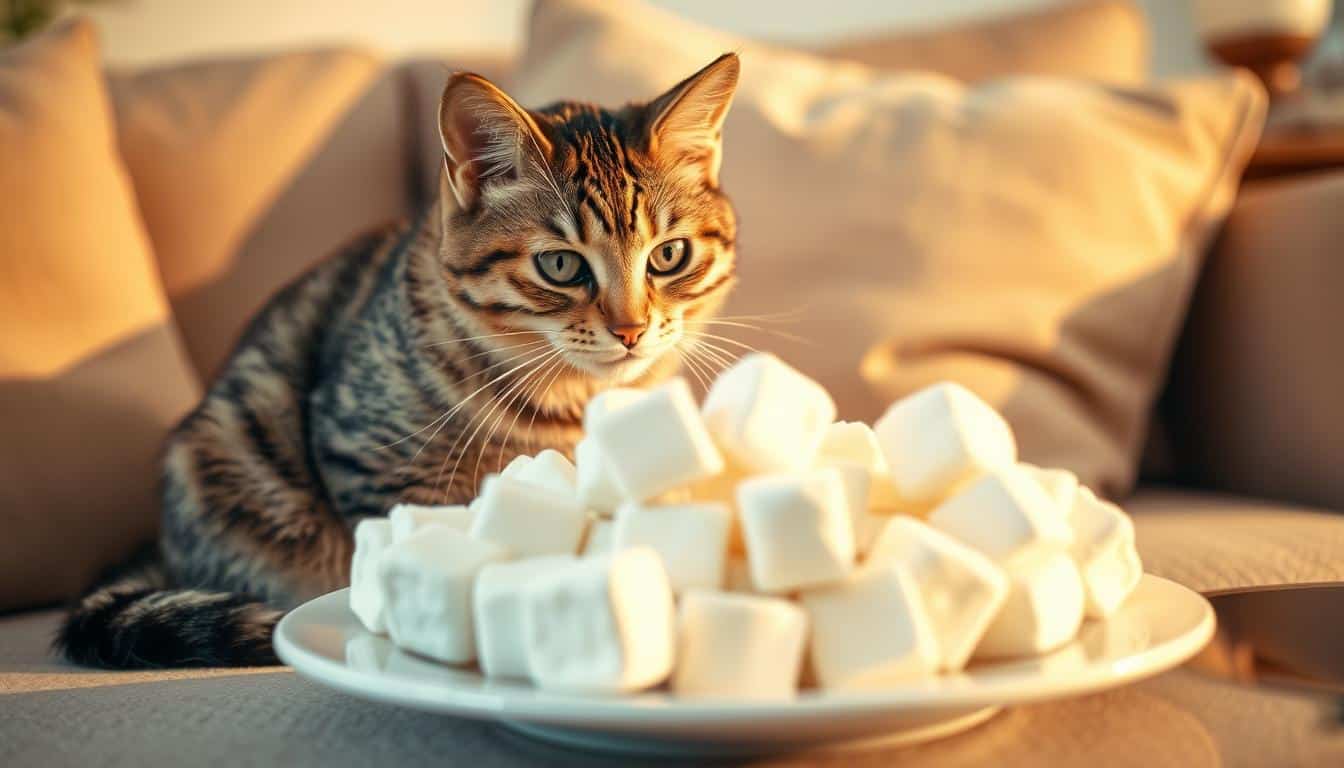Many pet owners wonder about sharing human treats with their feline companions. While marshmallows aren’t toxic, they provide zero nutritional benefits. These sugary snacks may seem harmless, but they pose health risks for cats.
Cats lack the enzymes needed to break down sugar effectively. High sugar content can lead to obesity and digestive issues. Artificial additives in marshmallows may also cause problems.
Popular treats like s’mores often include marshmallows, making them tempting to share. However, veterinarians agree sugary foods aren’t suitable for cats. Recent studies confirm their inability to process carbohydrates properly.
This article explores the science behind why marshmallows are a poor choice. It also highlights safer alternatives for treating pets responsibly.
What Are Marshmallows Made Of?

Sugar and gelatin dominate the ingredient list of these popular campfire treats. A standard recipe blends 45% sugar, 25% corn syrup, and 15% gelatin, creating their signature spongy texture. Water binds the mixture, while vanilla extract or artificial flavors enhance taste.
Gelatin, derived from animal collagen, gives marshmallows their bounce. Without it, they’d lack the fluffy consistency loved in s’mores or hot cocoa. Commercial varieties often add food dyes and preservatives like potassium sorbate to extend shelf life.
Homemade versions skip synthetic additives but still pack sugar. A 28-gram serving delivers 100 calories—mostly empty carbs. For comparison, felines require protein-rich diets, not sugary human foods.
“Chocolate-coated marshmallows double the danger, combining sugar with theobromine, toxic to pets.”
During holidays or camping trips, these treats appear everywhere. Their sweetness appeals to people but offers zero nutritional value for animals. Always check labels for xylitol, another hidden hazard in sugar-free varieties.
Are Marshmallows Safe for Cats?

Feline biology makes sugar consumption unnecessary and potentially harmful. As obligate carnivores, their digestive systems evolved to process meat, not carbohydrates. Unlike humans, they lack taste receptors for sweetness, making sugary treats biologically irrelevant.
Why Cats Lack Nutritional Need for Sugar
Wild ancestors thrived on prey containing 70%+ protein, shaping modern carnivores. Their bodies struggle to metabolize sugar, often converting excess carbs into fat. This inefficiency explains why obesity and diabetes are common in pets fed human snacks.
Dental health also suffers. Plaque thrives on sugary residues, accelerating periodontal disease. Even small amounts disrupt gut bacteria, causing bloating or diarrhea.
The Sticky Texture Hazard
Marshmallows’ sticky texture adheres to throats, especially in flat-faced breeds like Persians. Gelatin swells when wet, risking intestinal blockages if swallowed whole. Emergency vet visits often involve these digestive systems complications.
“A pea-sized piece can obstruct a cat’s airway within seconds.” — Forgetful Mama
Unlike dogs, felines cannot regurgitate easily. Their narrower esophagus traps sticky masses, requiring urgent intervention.
Health Risks of Feeding Marshmallows to Cats
Empty calories in marshmallows pose multiple threats to feline health. These treats lack essential nutrients while packing sugars and additives. Even small amounts can disrupt a pet’s metabolic balance.
Obesity and Weight Gain
One marshmallow equals 5% of a cat’s daily calorie needs. Four treats exceed their energy requirement, forcing fat storage. Unlike humans, felines convert excess carbs into visceral fat, raising diabetes risks.
Digestive Issues and Sodium Poisoning
Digestive systems struggle with gelatin and sugar, causing vomiting within hours. High sodium levels (42mg/kg) risk ion poisoning. A Persian cat案例 required urgent care after three marshmallows.
Xylitol and Chocolate Dangers
Sugar-free varieties often contain xylitol, triggering hypoglycemia. Chocolate coatings add theobromine—lethal at 20mg/kg. The ASPCA Poison Control (888-426-4435) handles such emergencies.
“Visceral fat from sugary snacks directly impacts organ function.” — Bailey’s CBD
What to Do If Your Cat Eats a Marshmallow
Accidental ingestion of sugary snacks requires immediate action from pet owners. Quick *monitoring* helps identify severe reactions like choking or lethargy. Contact a veterinarian if multiple treats are consumed.
- Assess the quantity: One marshmallow may pass harmlessly, but multiples risk blockages.
- Watch for symptoms: Excessive drooling, vomiting, or diarrhea signal distress.
- Skip home remedies: Activated charcoal should only be administered by professionals.
Chocolate-coated varieties demand urgent vet care. Theobromine toxicity can cause tremors within hours.
“Blood tests detect hyperglycemia, while IV fluids combat dehydration.” — Bailey’s CBD
Most cases resolve in 48 hours with observation. Pet insurance offsets emergency costs for future incidents.
Healthy Alternatives to Marshmallows for Cats
Swapping sugary snacks for healthy alternatives ensures pets thrive without empty calories. Felines benefit from protein-rich treats aligned with their carnivorous needs. Below are vet-approved options to satisfy curiosity safely.
Catnip and Its Benefits
This herb induces a harmless euphoria, making it a favorite among catnip enthusiasts. It stimulates playfulness while reducing stress—ideal for enrichment toys or puzzle feeders.
- Portion control: Offer fresh or dried leaves 2–3 times weekly.
- Enrichment: Stuff toys with catnip to encourage activity.
“A pinch of catnip mimics natural hunting highs safely.” — Forgetful Mama
Lean Meats and Fish Options
Lean meats like cooked chicken breast provide essential amino acids. Freeze-dried salmon or tuna water ice cubes add variety while boosting hydration.
- Safe prep: Debone fish and remove skin to avoid choking.
- Commercial picks: Purina Fancy Feast offers balanced treats.
Limit rewards to ≤10% of daily calories—about 2–3 small portions weekly. Homemade options often cost less than premium brands like Bewi Cat Salmon.
How to Keep Cats Away from Marshmallows
Protecting pets from harmful snacks starts with smart home strategies. Simple changes in storage and routines create effective prevention against accidental ingestion.
Use locking cookie jars or airtight containers for sugary treats. Place them in high cabinets—far from agile jumpers. Storage solutions like magnetic child-proof latches add extra security.
Designate cat-free zones during meal prep or parties. Baby gates or closed doors keep curious companions safe. For counter surfers, try clicker training with protein rewards instead.
“Guests often unknowingly offer dangerous foods. A quick chat about feline diets prevents mishaps.” — Bailey’s CBD
Interactive demonstrations teach children proper feeding habits. Show them how to offer approved treats like freeze-dried chicken. This education builds lifelong responsible pet care skills.
Check treat ingredients before travel or gatherings. Motion-activated deterrents work well in hotel rooms. Separate dog and cat treat areas in multi-pet households to avoid mix-ups.
Prioritizing Your Cat’s Health Over Curiosity
Choosing safe alternatives over human snacks shows true care for feline well-being. Annual vet visits catch diet-related issues early, saving money long-term. Prevention beats treatment every time.
Tailor meals to life stages—kittens need more protein than seniors. Always check labels for AAFCO-approved ingredients. Small changes, like swapping treats for lean meats, make big differences.
Partner with a veterinarian to create custom nutrition plans. They help balance diet needs while keeping pets happy. Resist sharing table scraps, even when those eyes beg.
Commit to species-appropriate feeding. It’s the best way to prioritize health and longevity. Every choice matters in building a thriving life for furry companions.





